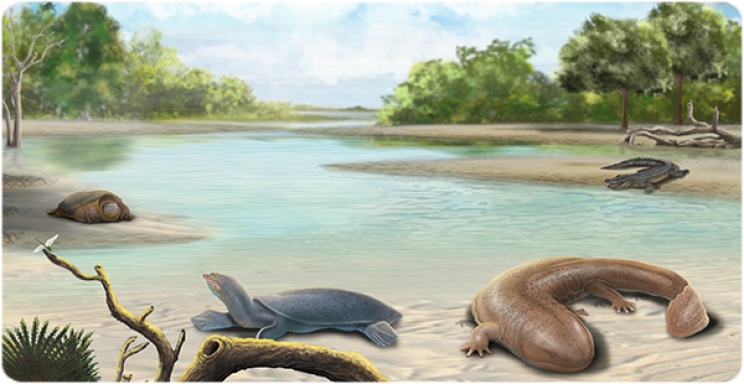Soft-shell turtles (Trionychidae) are typical freshwater turtles with shells covered by skin and short trunks and thanks to it they look like small piggies. Due to their freshwater preferences and thick shells, they are very common in the fossil record, especially in the Miocene fossil sites of Europe. During the early Miocene, two different species occupied Europe: Trionyx vindobonensis located in Western, Southern, and partly Central Europe and Rafetus bohemicus confirmed only from Czechia. This mysterious species was mandatory to study in detail and an international team of researchers decided to take up the reins.
According to the shell, the researchers could confirm the affiliation to soft-shell turtles, however, the diagnosis at the species level was tricky. Soft-shell turtles have very variable shells, and a new diagnostic element was necessary to find. Several skulls of fossil soft-shell turtles are known from Břešťany, a small historical fossil site in North-West Bohemia, circa 100 Km from Prague, which seemed promising. The study aimed to find new diagnostic characters on the skulls and shells to distinguish both species.
To correctly understand the morphology of the skulls and avoid destruction of them, a powerful CT scan housed at the Center Telč of the Czech Academy of Science has been used. Thanks to it we were able to prepare a digital model of the skull. The model shows all the necessary details; however, we are limited by the state of preservation of the material from Břešťany.

Fossil skull of Rafetus bohemicus with its 3D model.
Surprisingly, we found several differences between the skulls of Trionyx vindobonensis and Rafetus bohemicus. In more detail, Rafetus bohemicus has a more rounded and shorter snout, short intermaxillary suture and large internal naris. All differences are listed in the paper. “With the cranial material we can easily recognize fossil soft-shell turtles from Europe“, says Milan Chroust, co-author of the study from the Charles University.
Also, the total revision of previously published material from the Most Basin (Czechia) has been done with all figures and details. “Most of the specimens have been untouched for hundred years and their taxonomy was unknown to paleontologists abroad”, explains Àngel H. Luján, co-author of the study and main researcher from ICP.

Fossil shells of Rafetus bohemicus with its drawings.
The evolution of Rafetus lineage is still unknown. The extant two species occupied the Middle East (Syria, Turkey) and South-East Asia (China, Vietnam). Rafetus bohemicus is the oldest representative of the lineage and surprisingly has been discovered in Central Europe instead of Asia, which was thought before. More fossils of soft-shell turtles are essential for the reconstruction of the evolution of these amazing creatures.
Main image: Paleoenvironmental reconstruction of the Miocene fossil site of Břešťany (Czechia). (Roc Olivé / © Institut Català de Paleontologia Miquel Crusafont. With the collaboration of Fundación Española para la Ciencia y la Tecnología – Ministerio de Economía, Industria y Competitividad).
Research article:
- Chroust, M., Mazuch, M., Ivanov, M, Alba, D. M. Luján, À. H. (2023). Redescription of the soft-shell turtle Rafetus bohemicus (Testudines, Trionychidae) from the Early Miocene of Czechia. PeerJ. DOI: https://doi.org/10.7717/peerj.15658/table-1










